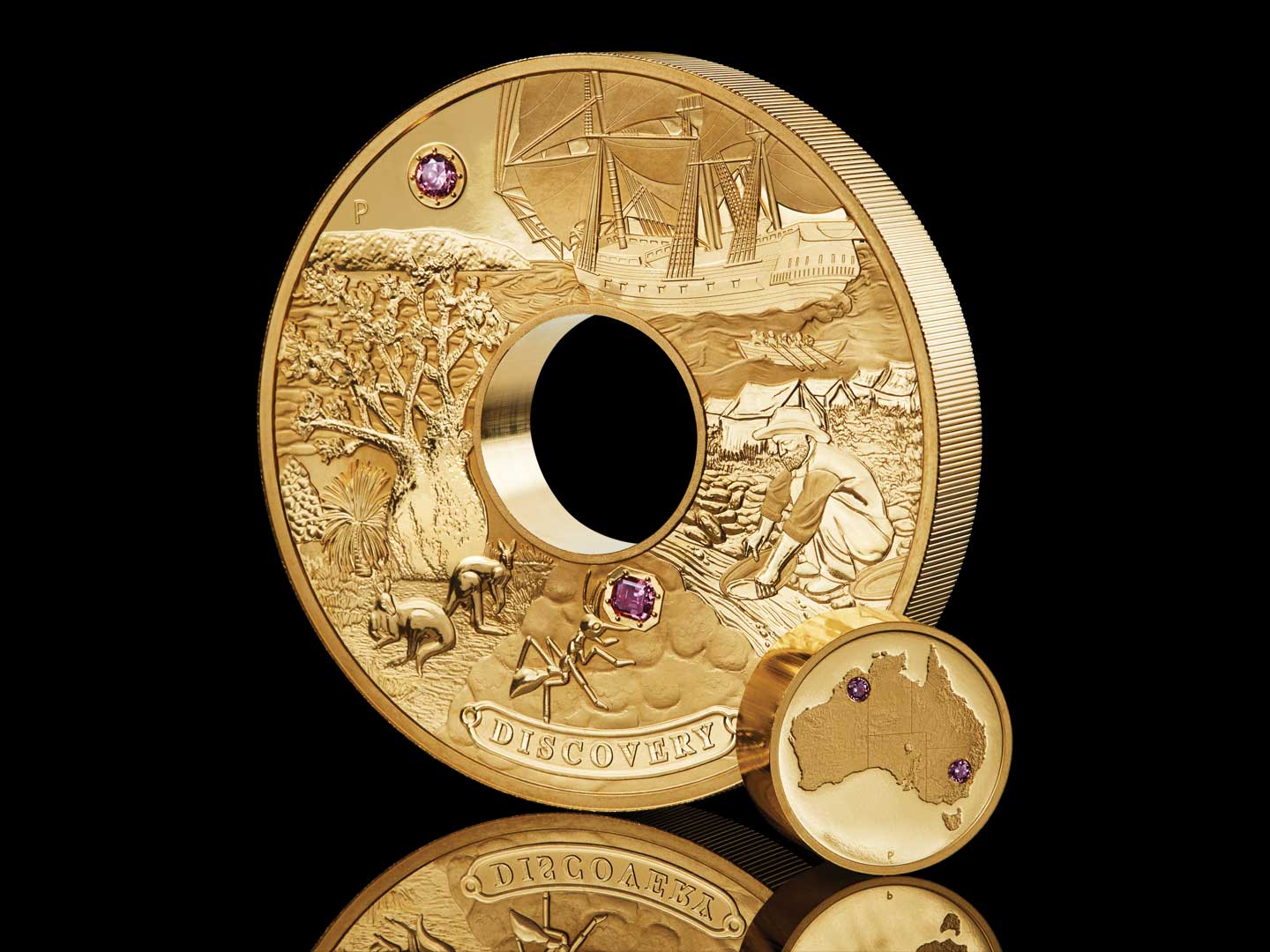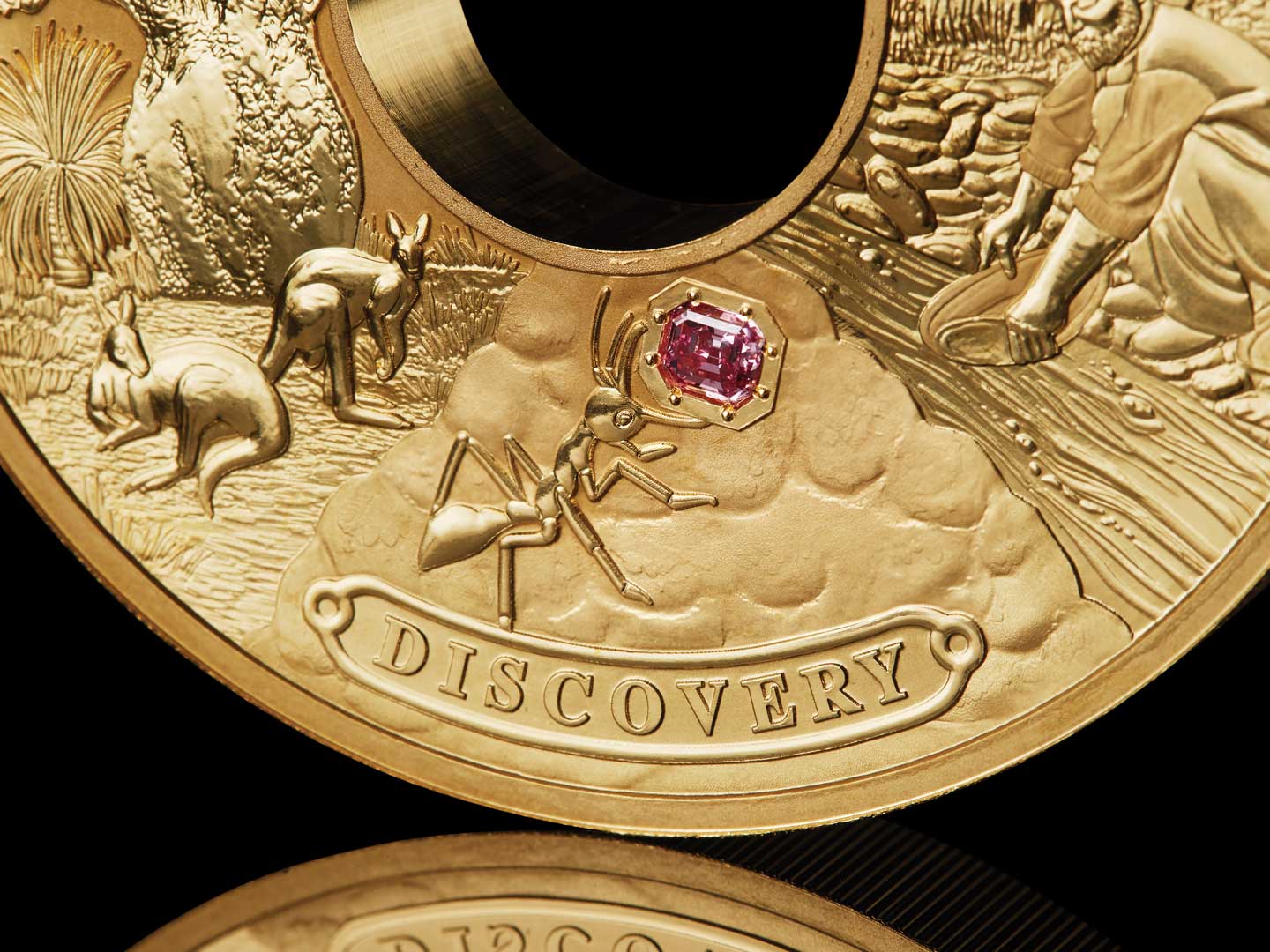Perth Mint unveils its multi-million dollar ‘Discovery’

The Perth Mint is defining a new category of exclusive coin collectables. With recent releases such as Kimberley Treasure, Trilogy and The Jewelled Phoenix, we have crafted extraordinary precious metal treasures handset with mesmerizingly rare and beautiful pink diamonds.
The latest creation to join this elite category is Discovery. Aimed at the highest echelons of the rare coin, art and diamond markets, the sumptuous one-of-a-kind collectable fuses 2kg of pure gold with four spectacular Argyle Pink Diamonds in a stunning celebration of their discovery in Australia’s vast outback.
Struck in sublime proof quality, Discovery comprises an outer coin and centrepiece emulating colonial Australia’s first official coinage – the historic ‘holey dollar and dump’.
Behind the design
An enthralling metal that has possessed mankind’s imagination for millennia, gold was destined to play a major role in the development of modern Australia.
Famously found at Ophir in New South Wales in 1851, it was subsequently discovered in such abundant deposits that the continent was gripped by not one, but two of the world’s greatest gold rushes.
Determined to seek their fortunes, hundreds of thousands of prospectors from around the globe raced to Victoria’s gold fields during the 1850s where the diggings contained some of the richest deposits ever found.
Gold fever returned in equal measure during the 1890s when similarly fabulous finds were unearthed in Western Australia, a region that contributes a significant proportion of the world’s gold supplies to this day.
Socially, politically and economically, the impact of gold was profound. It also led to the discovery of other valuable minerals across the vast outback.
Yet it wasn’t until 1979 that the rugged Kimberley in the country’s far north-west revealed one of Earth’s most exquisite gemstones.
Billions of years earlier, deep beneath the surface, extraordinary natural forces had created the marvel of pink diamonds – and then thrust them upwards through narrow pipes of fast moving magma.
Standing atop the ancient landscape, a geologist first glimpsed one of these astonishing pink prizes glinting from the soil of an anthill.
An extraordinary twist of fate, the chance sighting resulted in the opening of the Argyle Diamond Mine in 1983 – the world’s largest supplier of natural coloured diamonds.
Feted worldwide for their spellbinding beauty, the coveted pink varieties are among the rarest gems known to man.
Discovery’s outer coin symbolises a sailing ship alongside a small rowboat ferrying hopeful diggers ashore, while a 19th century prospector pans for gold in front of miners’ tents.
The Kimberley is characterised by an iconic boab tree, two kangaroos and a stunning round cut pink diamond representing the tropical sun.
The artistry also depicts a worker ant on the surface of an anthill with a spectacular emerald cut pink diamond between its mandibles.
Among the finest examples of Argyle pink diamonds unearthed in the Kimberley, both handset stones were originally showcased at the prestigious Argyle Pink Diamond Signature Tender.
On average only 50 to 60 such stones are offered annually by this exclusive invitation-only process.
The centre coin is inscribed with a representation of the Australian continent with two additional inset pink diamonds indicating the location of Ophir in the southeast and the Argyle Diamond Mine in the northwest.
Diamond authentication

From a gemstone perspective, each of the four fancy pink diamonds in the coin’s reverse is accompanied by an original gem identification and authenticity document from Argyle Pink Diamonds. In the case of the two largest stones, a 1.02 carat emerald cut and a 0.88 carat round cut, they are also accompanied by a GIA Coloured Diamond Report issued by the Gemological Institute of America (GIA).
Nevertheless, the Mint went above and beyond these authoritative documents by engaging expert Sarah Claire Edwards to provide an independent, third-party assessment of each stone.
She began by conducting a forensic investigation to confirm the origin, history and rarity of each diamond. The investigations included physical inspections to verify that each stone matched the existing certification.
Sarah also satisfied herself that the larger stones had previously been part of the official Argyle Pink Diamonds Tender – an exclusive annual sale reserved for a small number of important rare diamonds of remarkable vibrancy and intensity.
Colour-grading fancy pink diamonds is a particularly complex and specialised process, and the significance of the outcome typically outweighs the other three ‘Cs’ (clarity, cut and carat).
There is different nomenclature used by Argyle and GIA. Both systems grade an increase of colour saturation and a colour modifier.
Asked to provide her own assessment of each diamond’s precise colour, Sarah formed her opinion with the aid of the Munsell colour chart – which describes colour according to three attributes – lightness, chroma and hue.
Other aspects of her work were also designed to ensure that the diamonds can continue to be identified once set within the coin where their laser inscribed numbers are hidden from view.
Important elements of this assurance included rating the symmetry and the cut while also mapping the inclusions that form the clarity grade.
Another diagnostic check she conducted was recording the diamonds’ fluorescence – their tendency to emit a soft coloured glow when subjected to ultraviolet light of both short and long wavelengths.


















